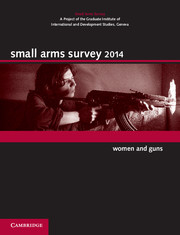Book contents
- Frontmatter
- Foreword
- Contents
- About the Small Arms Survey
- Notes to readers
- Acknowledgements
- Introduction
- Chapter 1 In War and Peace: Violence against Women and Girls
- Chapter 2 Converging Agendas: Women, Peace, Security, and Small Arms
- Special Feature. Women behind the Gun: Aiming for Equality and Recognition
- Chapter 3 Breaking New Ground?: The Arms Trade Treaty
- Chapter 4 Trade Update: Transfers, Retransfers, and the ATT
- Chapter 5 Countdown to Catastrophe: The Mpila Ammunition Depot Explosions
- Chapter 6 Across Conflict zones: Ammunition Profiling
- Chapter 7 Signs of Supply: Weapons Tracing in Sudan and South Sudan
- Chapter 8 On the Record: Illicit Weapons in the the United States
- Index
Chapter 2 - Converging Agendas: Women, Peace, Security, and Small Arms
Published online by Cambridge University Press: 05 July 2014
- Frontmatter
- Foreword
- Contents
- About the Small Arms Survey
- Notes to readers
- Acknowledgements
- Introduction
- Chapter 1 In War and Peace: Violence against Women and Girls
- Chapter 2 Converging Agendas: Women, Peace, Security, and Small Arms
- Special Feature. Women behind the Gun: Aiming for Equality and Recognition
- Chapter 3 Breaking New Ground?: The Arms Trade Treaty
- Chapter 4 Trade Update: Transfers, Retransfers, and the ATT
- Chapter 5 Countdown to Catastrophe: The Mpila Ammunition Depot Explosions
- Chapter 6 Across Conflict zones: Ammunition Profiling
- Chapter 7 Signs of Supply: Weapons Tracing in Sudan and South Sudan
- Chapter 8 On the Record: Illicit Weapons in the the United States
- Index
Summary
INTRODUCTION
In April 2013, cautious celebrations greeted the news that the United Nations General Assembly had finally adopted the Arms Trade Treaty (ATT). The ATT has been hailed as a victory for women in that it will require states parties to take into account the risk of small arms being used to commit or facilitate serious acts of gender-based violence, such as domestic and sexual violence, before authorizing their transfer abroad. For women's civil society organizations (CSOs) and disarmament CSOs, which have often joined forces, this marks an important achievement in the long struggle to prevent the misuse of small arms.
The years 2012–13 saw multiple causes for celebration, as the international women, peace, and security and small arms agendas have finally converged within international policy. The outcome of the 2012 Review Conference of the UN Programme of Action (PoA), the ATT, and the September 2013 United Nations Security Council Resolution (UNSCR) on small arms control each include specific language on gender-based violence or women's participation. In parallel, the two 2013 resolutions on women, peace, and security both reaffirm the provisions in the ATT; the second of these, UNSCR 2122 of October 2013, contains a groundbreaking operative paragraph urging women's full participation in controlling illicit small arms.
Such policy coherence was not always the case. Earlier international law and policies, such as the 1979 Convention on the Elimination of All Forms of Discrimination against Women (CEDAW) and the 1995 Beijing Declaration and Platform for Action (PfA), set the stage for addressing the differing ways in which small arms affect and involve men, women, girls, and boys.
- Type
- Chapter
- Information
- Small Arms Survey 2014Women and Guns, pp. 34 - 63Publisher: Cambridge University PressPrint publication year: 2014

